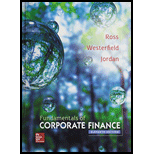
To determine: The standard deviation of the stock.
Introduction:
Expected return refers to the return that the investors expect on a risky investment in the future.
Standard deviation refers to the variation in the actual returns from the expected returns.
Answer to Problem 13.1CTF
The standard deviation of the stock is 3.82 percent.
Explanation of Solution
Given information:
A stock’s return is 15 percent when the economy is in a boom and 7 percent when the economy is normal. The probability of having a booming economy is 35 percent, and the probability of having a normal economy is 65 percent.
The formula to calculate the expected return on the stock:
The formula to calculate the standard deviation of the stock:
Compute the expected return:
“R1” is the returns in a booming economy. The probability of having a booming economy is “P1”. Similarly, “R2” is the returns in a normal economy. The probability of having a normal economy is “P2”.
Hence, the expected return on the stock is 9.8 percent.
Compute the standard deviation:
“R1” is the returns in a booming economy. The probability of having a booming economy is “P1”. Similarly, “R2” is the returns in a normal economy. The probability of having a normal economy is “P2”.
Hence, the standard deviation of the stock is 3.82 percent.
Want to see more full solutions like this?
Chapter 13 Solutions
Fundamentals of Corporate Finance with Connect Access Card
- Explain how an increase in interest rates by a central bank could affect bond prices and stock market performance.arrow_forwardWhat is the purpose of diversification in an investment portfolio, and how does it reduce risk? Need help!arrow_forwardWhat are the key differences between a company’s income statement and its cash flow statement? Why are both important for financial analysis? Need help!arrow_forward
- What are the key differences between a company’s income statement and its cash flow statement? Why are both important for financial analysis?arrow_forwardWhat is the relationship between risk and return in finance, and how is this reflected in the Capital Asset Pricing Model (CAPM)? Explain.arrow_forwardDefine the time value of money (TVM). How does TVM influence decision-making in capital budgeting? Explanation.arrow_forward
- What is the relationship between risk and return in finance, and how is this reflected in the Capital Asset Pricing Model (CAPM)?arrow_forward3. Explain the concept of compounding. How does compounding impact the future value of an investment? Need help!arrow_forward3. Explain the concept of compounding. How does compounding impact the future value of an investment?arrow_forward
- What is the difference between a stock and a bond, and how do they function as investment options? Need help now !arrow_forwardWhat is the difference between a stock and a bond, and how do they function as investment options? Rxplarrow_forwardWhat does the internal rate of return (IRR) tell you about a potential investment? Rxarrow_forward
 Essentials Of InvestmentsFinanceISBN:9781260013924Author:Bodie, Zvi, Kane, Alex, MARCUS, Alan J.Publisher:Mcgraw-hill Education,
Essentials Of InvestmentsFinanceISBN:9781260013924Author:Bodie, Zvi, Kane, Alex, MARCUS, Alan J.Publisher:Mcgraw-hill Education,

 Foundations Of FinanceFinanceISBN:9780134897264Author:KEOWN, Arthur J., Martin, John D., PETTY, J. WilliamPublisher:Pearson,
Foundations Of FinanceFinanceISBN:9780134897264Author:KEOWN, Arthur J., Martin, John D., PETTY, J. WilliamPublisher:Pearson, Fundamentals of Financial Management (MindTap Cou...FinanceISBN:9781337395250Author:Eugene F. Brigham, Joel F. HoustonPublisher:Cengage Learning
Fundamentals of Financial Management (MindTap Cou...FinanceISBN:9781337395250Author:Eugene F. Brigham, Joel F. HoustonPublisher:Cengage Learning Corporate Finance (The Mcgraw-hill/Irwin Series i...FinanceISBN:9780077861759Author:Stephen A. Ross Franco Modigliani Professor of Financial Economics Professor, Randolph W Westerfield Robert R. Dockson Deans Chair in Bus. Admin., Jeffrey Jaffe, Bradford D Jordan ProfessorPublisher:McGraw-Hill Education
Corporate Finance (The Mcgraw-hill/Irwin Series i...FinanceISBN:9780077861759Author:Stephen A. Ross Franco Modigliani Professor of Financial Economics Professor, Randolph W Westerfield Robert R. Dockson Deans Chair in Bus. Admin., Jeffrey Jaffe, Bradford D Jordan ProfessorPublisher:McGraw-Hill Education





